The health care industry is buzzing about Life Care Centers of America’s (LCCA’s) success in reducing rehospitalizations from 40 percent to 15 percent in one year among facilities participating in their latest effort to improve quality care, says Beecher Hunter, LCCA president.
Rehospitalization reduction efforts are taking center stage as hospitals will start to be penalized, beginning this year, if one of their Medicare patients returns to the hospital within 30 days.
LCCA’s size is part of what has made its new initiative—to place a full-time doctor in every nursing facility—possible. LCCA has 225 skilled nursing facilities in 28 states and employs more than 35,000 people.
Assessing Benefits
This program goes far beyond what most long term care facilities are able to do on their own, and, if Hunter and Kenneth Scott, DO, LCCA’s chief medical officer and corporate medical director, have anything to say about it, the move will dramatically improve the quality of care and quality of life for thousands of LCCA residents across the country. The initiative is changing the clinical operations of LCCA nursing facilities in many ways, from measures that reduce antipsychotic use to those that improve cardiac care, but it is also changing the resident makeup in the facilities as hospitals turn to them with greater certainty that their more critically ill patients will be well taken care of and won’t wind up back in the hospital within a month, incurring penalties for the hospital.
Further benefits LCCA has noted since the program’s inception in September 2010 include reduced staff turnover, greater resident and family satisfaction, and improved clinical outcomes.
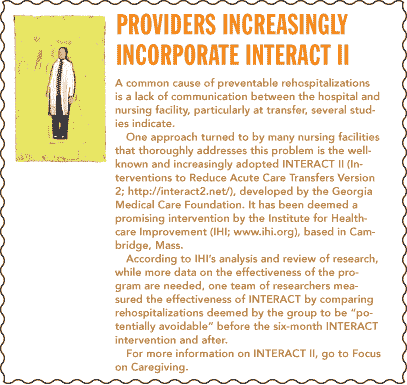
Steps For The Future
The increasing focus by health care policymakers on ways to reduce rehospitalizations may have consequences for the vast majority of nursing facilities, and while not all facilities have the wherewithal to hire full-time physicians, other studies laud the beneficial effect of having a nurse practitioner or physician’s assistant on staff.
And, of course, nursing facilities across the nation—including LCCA—are embracing the well-known INTERACT II program, which provides care paths, communication tools, and advance care planning tools with the goal of reducing hospitalizations by improving the identification, evaluations, and communication about changes in resident status.
Whatever approach is taken, nursing facilities will increasingly confront the need to care for even sicker patients with a team of staff who will require a higher level of training to care for them, catch conditions early, and intervene promptly.
Just The Facts
The rate of Medicare rehospitalization industry-wide has significantly increased over the past three decades (see graph).
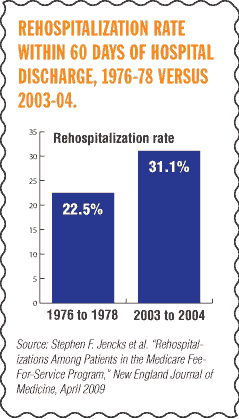
But the government is taking the issue on. This year, hospitals with high readmission rates will have to absorb a 1 percent penalty under the Hospital Readmissions Reduction Program, which places emphasis on three readmission-prone conditions: acute myocardial infarction, heart failure, and pneumonia. In the following two years, that penalty will go up to 2 percent and then 3 percent.
One out of every five Medicare beneficiaries discharged from the hospital is readmitted within 30 days at a cost to Medicare of over $17 billion annually, according to MedPAC, which also estimated that as many as 75 percent of readmissions are preventable.
According to a 2010 study, if potentially preventable rehospitalizations dropped by only 25 percent, Medicare could save more than $25 billion per year—a tidbit unlikely to escape the notice of federal budget slashers.
About 40 percent of hospitalized Medicare beneficiaries are discharged to a post-acute setting like a nursing facility, Alliance for Quality Nursing Home Care President Alan Rosenbloom said in a statement late last year. Information about the patient’s care lost during the transfer from hospital to nursing facility puts the patient at significantly higher risk for readmission, he added.
The New England Journal of Medicine published an influential study in 2009 that analyzed rehospitalization data from almost 12 million fee-for-service Medicare beneficiaries. Nearly 20 percent of those discharged from a hospital were rehospitalized within 30 days, 34 percent within 90 days, and 54 percent within a year. Of those who were discharged with a medical condition, 69 percent were readmitted or died within a year. If the beneficiary had surgery, the rate of readmission was 53 percent.
Motives Are Unselfish
Even though reducing rehospitalizations may not save nursing facilities any money—in fact, it may cost more—long term care providers are increasingly pursuing that goal anyway, some believing that higher quality care will bring its own rewards, like increased referrals.
That seems to prove true, judging by anecdotal evidence, but because those referrals will likely be of sicker residents, facilities may well be forced to staff up to meet those residents’ needs.
Rather, long term care providers are increasingly focused on reducing rehospitalizations not for financial gain but to improve the quality of life and quality of care for their residents by removing as much of the turmoil and discomfort of repeated hospital visits as they can, providers almost universally say.
To help manage this potentially dramatic change, as well as address the most pressing quality issues of the day, the American Health Care Association (AHCA) will unveil a new quality initiative near the end of this month. One of the “prongs” of that initiative will be reducing rehospitalizations.
AHCA will launch the new quality improvement initiative at its Quality Symposium in Houston Feb. 23 and 24. (For more information on the symposium or to register, visit
www.ahcancal.org and click on Events.)
The initiative builds on the past decade or more of AHCA efforts, from Quality First to Advancing Excellence, says David Gifford, AHCA’s senior vice president of quality and regulatory
affairs.
Gifford expects a positive reaction from members, once the initiative is made public. “AHCA and its members have said loud and clear that they really want to improve quality,” he says, “and we want to do it in a systematic way that really has an impact on organizations as a whole.”
Rehospitalization Triggers
The New England Journal of Medicine study found that five medical conditions were the most frequent causes of rehospitalizations: heart failure (27 percent return to the hospital within one month), pneumonia (21 percent), chronic obstructive pulmonary disease (23 percent), psychoses (25 percent), and gastrointestinal problems (19 percent).
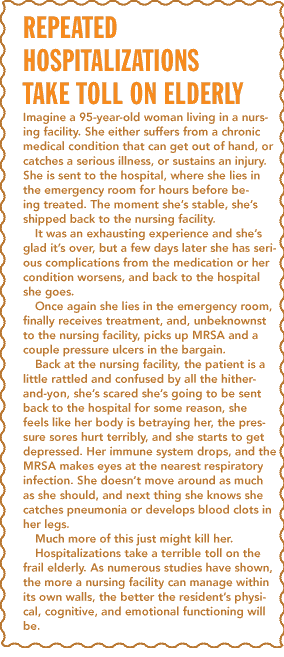
In a study of more than 10,000 hospital admissions published in the Journal of Hospital Medicine, unplanned readmission within 30 days was 24 percent to 33 percent more likely for people on high-risk medications such as narcotics or steroids.
A second, smaller study published in the same journal found that depression predicted a threefold risk of multiple readmissions, while being underweight raised the risk more than 12-fold.
A study published last year in the Journal of the American Medical Directors Association analyzed more than 10,000 hospital discharges of people aged 75 and over. The researchers found that patients with genitourinary disorders had the highest rate of readmission within seven days of initial discharge (30 percent).
The seven-day readmission rates for cardiovascular disorders (25 percent), urinary tract infection (28 percent), renal failure (27 percent), and infection (36 percent) were also high.
Other risk factors identified by various studies include cancer with metastasis and heart attack.
With so many risk factors, how does one design or choose a rehospitalization reduction program?
How To Develop A Program
The conditions that most frequently account for rehospitalizations vary from one facility to another, so any reduction program must be tailored, says Beecher.
The first step is to determine the facility’s rehospitalization rate. To do this:
■ Specify a time period, like 30 days;
■ Count the number of rehospitalizations during that period;
■ Divide that number by the facility’s average census during the 30-day period; and
■ Multiply by 100.
Not all of these rehospitalizations will be avoidable, of course; the director of nursing (DON) or administrator will need to review each rehospitalization to identify those that were potentially avoidable and flag any conditions that crop up again and again as good prospects for initial efforts.
Next, set up a task force to develop the rehospitalization prevention program, involving the DON, nurse supervisors and leaders, and certified nurse assistants (CNAs) from all three shifts. This team assesses facility resources to identify which resident conditions can be managed at the facility and which need an acute care setting.
The team develops or acquires systems, protocols, and clinical pathways to assist nursing staff with clinical decision making (check out the INTERACT II tools or “How-to Guide: Improving Transitions from the Hospital to Skilled Nursing Facilities to Reduce Avoidable Rehospitalizations,” available from the Institute for Healthcare Improvement, based in Cambridge, Mass., and free on its website,
www.ihi.org).
An emphasis on improved communication between nursing facility and hospital, especially through the transfer process, is crucial. Also, don’t forget to address advance planning. Without it, residents will be sent to the hospital even if their preference would be for less invasive care at the end of life.
After that, the team will be able to determine what training, supplies, or other tools will be necessary to make the program work.
Finally, set up a system for measuring the program’s success rate. Consider having debriefing sessions following each rehospitalization to identify glitches, potential problems, or ways to make the process flow more smoothly.
And, if the company is able, it can do all of the above plus hire a full-time physician for each facility.
How The LCCA Idea Originated
The events setting in motion what would one day be the buzz of the health care industry started long ago when Forrest Preston, LCCA’s founder and chief executive officer, met Scott, then a hospitalist caring for a member of Preston’s family, who came to the hospital with atrial fibrillation.
As Scott worked to stabilize his patient, the two men discussed her care, of course, but also Scott’s 16 years as a hospitalist and his success in building new hospitalist programs while carrying a full case load.
By the time the patient was ready to leave the hospital, Scott had made an enduring impression on Preston. He remembered Scott when he needed a corporate medical director who knew how to design and implement programs to improve quality of care.
“Life Care had been planning this approach” for some time, says Hunter.
But efforts to bring DONs and medical directors into gatherings where they could both earn continuing education credits and talk shop with their peers to get ideas on how to handle various clinical issues back at the facility still weren’t enough to get the outstanding results Preston was looking for.
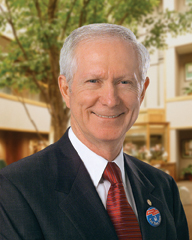
Four or five years ago, Preston started talking with greater determination about finding new ways to improve clinical outcomes, says Beecher.
In 2009, “Preston approached me about the whole concept of having a larger physician presence in the [facilities] and having full-time physicians for each nursing home,” says Scott. “When we began, the whole thrust was simply to improve the quality of care.”
“During the formative process of trying to figure out how we were going to do this,” Scott says, he and Hunter were influenced by the New England Journal of Medicine study that reported a 20 percent rehospitalization rate for Medicare patients across the nation, “and that the cost of those rehospitalized within 30 days was exorbitant.”
“I brought it to Forrest and Beecher, [saying] ‘if we put a doctor in each nursing home [rehospitalizations are] something we could impact,’” says Scott.
For the past 15 months, Scott has been hunting down the best doctors possible who have what it takes to be a long term care physician, placing them in LCCA facilities, and watching the rehospitalization rates plummet.
Common Conditions
Nearly 6 million Americans live with congestive heart failure, according to the American Heart Association. It’s the fasted growing cardiac disease in the United States. More than half a million new cases of congestive heart failure are diagnosed and 300,000 people die from the condition each year.
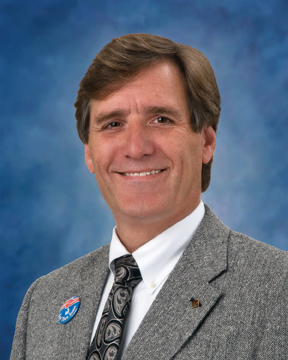
“If you look at some of the data just on congestive heart failure, the return to hospital from a nursing facility is about 32 percent across the nation,” says Scott.
Ten years ago, a patient with congestive heart failure stayed in the hospital an average of eight days, says Scott. Today that average is four days, “and the way we [treat] congestive heart failure hasn’t changed that much” over the past decade, he says. So patients with congestive heart failure are being transferred to a nursing facility when the patient is sicker and more frail than in the past.
A hospital can stabilize an acute congestive heart failure patient in four days. Based on the DRG that Medicare pays, it is difficult financially for a hospital to keep a patient with congestive heart failure much longer than four days. The thing is, what hospitals in the recent past did for the patient on those next four days was adjust medications so that all the dosages were working at peak efficiency.
Because these patients are being transferred to nursing facilities before dosages are worked out to their best benefit, problems can arise, often due to incomplete information received from the hospital during the transfer.
For example, if a patient is on a diuretic but the dosage is too high, he or she may dehydrate and get dizzy, fall, and come back to the hospital with a broken hip. If a doctor were on staff who had been treating that patient, he or she may have known from past experience that this patient has a strong reaction to a diuretic, or at the very least would be able to monitor the patient’s reaction to dosages closely and adjust them accordingly—and quickly.
Another illustrative issue with congestive heart failure patients who are transferred early to a nursing facility is that the facility’s direct care staff are responsible for picking up on any indications of returning congestive heart failure. But that’s a complicated thing to diagnose, says Scott.
“If it were as simple as monitoring weight,” that would be one thing, he says, “but it’s more complicated than that in many patients. So the very fact that we have our on-site, full-time physician to monitor these patients means more symptoms will be caught early enough for the nursing facility to manage the patient without a rehospitalization in many cases,” Scott says.
At one LCCA facility, rehospitalization rates overall have dropped from about 40 percent to a startling 8 percent within four months of hiring a full-time doctor, and that rate has been sustained at between 8 and 10 percent for several months.
Other Benefits
Having a full-time doctor on site also eliminates the rehospitalizations that occur because the regular on-call physician isn’t available.
Say a patient presents with fever, and the medical director, before going off-call, ordered a bunch of laboratory tests. The labs, arriving after the doctor is no longer available, indicate to the nurse that the resident has a urinary tract infection (UTI). She calls the doctor, but since he’s not available, she calls the doctor who’s filling in. That fill-in doctor has no relationship with the resident, hasn’t seen the resident, and doesn’t know the nurse or how accurate her reading of the labs is.
Worried about both the patient and his own legal risk, the doctor instructs the nurse to send the patient to the emergency room. An on-staff physician, on the other hand, is familiar with the nurse, the facility’s capabilities, and the resident’s medical history and is more likely to instruct the nurse on how to manage the UTI at the facility.
Another benefit of the on-site doctor is that he or she can improve many other aspects of nursing facility care. They lift the quality of care for all patients, of course, but they also provide superior education to nurses and CNAs, and, anecdotally, their mere presence results in higher satisfaction rates with patients, families, and staff.
“We’re hearing how excited [families] are that they can walk into the building on a given day of the week, and talk to the doctor about their loved one,” says Scott. LCCA is about to launch a customer satisfaction survey to quantify the effect that on-site doctors are having on satisfaction.
Effects On Staff
Staff turnover also appears to be dropping in facilities that employ a physician, says Scott. The information is purely anecdotal at this point, but some LCCA facility administrators have told Scott that they’re seeing greater retention of nurses and CNAs and reduced overtime.
Another big benefit is the speed with which a decision on whether the resident should go to the hospital can be reached. In a nursing facility without a doctor, the nurse, in the event of a potentially serious condition with a patient, will call the on-call doctor, leave a message, and wait hours for a response.
“By the time the doctor gets back [to them] and they finish their paperwork, they’re late in leaving,” says Scott. “Now, with a doctor on site full-time, they’re [not only] getting their orders on time and finishing their paperwork on time,” but have the satisfaction of seeing that the residents they’re concerned about are getting immediate attention. That improves their job satisfaction.
“It’s an extra level of motivation for all of us: having an impact on residents’ personal and physical lives,” says Hunter.
Another reason staff satisfaction appears to be improving is just the mere fact that the doctor is working with them. “Part of the problem over the years with nursing home work is the lack of respect for what we do from the rest of the health care industry,” says Scott. Once a doctor is on staff full-time, direct-care staff seem to feel that if the work is important enough for a doctor to be there with them all day because patients are coming in sicker, their own work must be getting more important, too. Plus, the doctor can come up to a CNA and say, “Great job!” and that means all the world to them, Scott says.
“The other aspect that I’m seeing glimpses of, and it will take a little longer to produce the data, but one of the big concerns with the state Medicaid programs is the cost of long term care patients in a nursing home. And the bottom line is that with a full-time doctor, the long term care census is starting to go down.
Patients come in and either get better and go home or get worse and go back to the hospital or don’t progress and stay on the long term care side.
“With the doctor there, more are getting better and going home. Before the intervention, every time a resident came back from a hospital he or she was weaker and worse off. Now they’re continuing to get better and reentering society. So, it’s reducing the cost of the Medicaid as well as Medicare program.”
Having full-time doctors has also resulted in reduced use of antipsychotics, says Scott. LCCA is still in the midst of collecting further data about the rehospitalization rates by a number of factors, but anecdotally the doctors appear to be making a huge difference.
Finding The Right Doctor
Finding a physician just to make rounds at the facility periodically can be difficult because Medicare reimbursement rates for seeing a patient in the nursing facility is lower than treating that same patient in his or her office. Outpatient reimbursement is much better. Even doctors who do visit nursing facilities must have a high enough volume to cover costs, and so they don’t spend all their time in one building but visit several. It’s great that the residents get to see a doctor periodically, but it doesn’t compare to having a doctor right there the moment something goes south.
Just getting a doctor into all of LCCA’s 225 buildings appropriate for the intervention is consuming most of Scott’s time right now. He must not only locate doctors interested, but “you have to have a doctor who really understands long term care,” says Scott. “Even for full-time geriatricians, there’s an adjustment to being full-time in a nursing home. It can be hard to predict.”
Getting the right doctor into each facility will “take a little time,” Hunter says. “We’re really focusing our energy on that.”
The newly hired physicians aren’t given special training on how to operate within a nursing facility environment, but LCCA does bring them to the company’s headquarters in Cleveland, Tenn., for orientation and discussion of what goals the company is trying to achieve.
Increased Referrals
The LCCA facilities that have demonstrated tremendous reduction in rehospitalizations are seeing increases in hospitals discharging to them more compromised residents in hopes that they will help protect the hospital from being financially penalized by returns within 30 days.
Despite hospitals sending sicker patients to LCCA facilities, “for the most part we’re still managing to keep those rehospitalization rates down,” says Scott, “but it’s becoming much more work for our doctor. I’m sure there’ll be a point where that’s maxed.”
“In a Florida LCCA building, our doctor’s return-to-hospital rate has remained 6.8 percent to 8 percent for about six months, and in November that rate was 5.8 percent,” says Scott. “In December, his rate was 10 percent, and he says it’s truly because of the patients he’s getting. But the hospital is going to push the boundaries.”
“Once we put a doctor in a building it even broadens the scope of what we can do,” says Scott. “We can take much more critically ill patients. It allows us to develop new programs, such as a cardiac care program in one of our Florida buildings.”
What’s Next?
Scott, focused as he is on getting top-notch doctors into LCCA’s facilities, already looks to the future. “I think this next year will be a banner year for us,” he says. “It took me about a year of working with Forrest, Beecher, and the team here to come up with a plan that we thought would work. In the past 15 months we’ve hired 33 doctors for 33 buildings, and at some point you start to get into a rhythm, and I think we’re there.” Scott expects 2012 to see LCCA “bust this open and hire at a more rapid pace, with the end effect of better quality of care and cost savings to the overall health care system.”
Once LCCA achieves a “critical mass of doctors in an area, camaraderie springs up among those doctors,” Scott says. “All the Arizona doctors get together once a month and talk about what’s working in their building, what issues [must be addressed] to improve quality of care,” among other related topics, Scott says.
“I think that process is the next step,” says Scott. “We have committed physicians in this process. I learn from them. We take those gains, and we use that to improve what we’re doing across the nation.
“Next is a physician-led program that results in the quality-of-care outcomes [that the company has seen in its efforts to reduce rehospitalizations], which not only improves the care but also reduces the cost to the federal government,” Scott says. “We’re seeing that on the bounce-backs, but I think we’re going to see it in other areas, and those doctors” will be leading the charge.
“We hope that other companies will follow suit on this,” says Hunter. “The more companies that do that, [the] greater the positive impact on the residents we all service, and good for all is good individually.”
Kathleen Lourde is a freelance writer based in Dacoma, Okla.